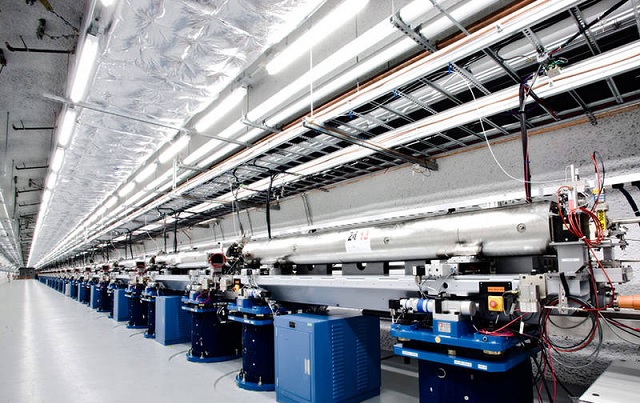 Undulator hall at the Linac Coherent Light Source of SLAC – Photo: SLAC National Accelerator Center.
Undulator hall at the Linac Coherent Light Source of SLAC – Photo: SLAC National Accelerator Center.
The ultra-short and intense X-ray flashes generated by free-electron lasers can be used to study the orientation of atoms within the molecules. Researchers at the Technische Universität München have developed a new method which is able to investigate the intensity of X-ray flashes in order to improve spatial and temporal resolution.
The duration of X-ray pulses were measured by the researchers using a method which was originally used to detect ultra-short flashes of light. The team at the Technische Universität München introduced X-ray flashes into a vacuum chamber containing an inert gas to superimpose the flashes with infrared light of 2.4µm wavelength pulses.
Electrons were knocked out of their innermost shells when the flashes struck a single atom of the inert gas. The electrons were either accelerated or decelerated in the electrical field of the infrared pulse after being liberated.
The electrons emitted at different points possed different field strengths of infrared light and hence they were accelerated at different rates. This enabled the scientists to calculate the original X-ray flash duration based on the different arrival times of the electrons in the detector.
The findings suggested that the average pulse duration is not more than four and a half femtoseconds. The researchers also studied the structure of the X-ray flashes. They managed to measure the sub-peaks of ultra-short pulses directly for the first time and confirm the predictions of individual flashes lasting for 800 attoseconds.
Ultra-short laser-like X-ray pluses serve not only the investigation of the fastest physical processes at the core of matter, but could, because of their extremely high intensity, also be used to destroy tumors following X-ray diagnosis.
Reinhard Kienberger, Professor for laser and X-ray physics at TU München and leader of the research consortium
Researchers at the Center for Advanced Laser Applications (CALA) at the Garching campus are working on producing shorter X-ray pulses by means of high-energy lasers. Using pulses with short duration would enable them to take snapshots of faster processes within the atom such as movement of electrons around the atomic nuclei.